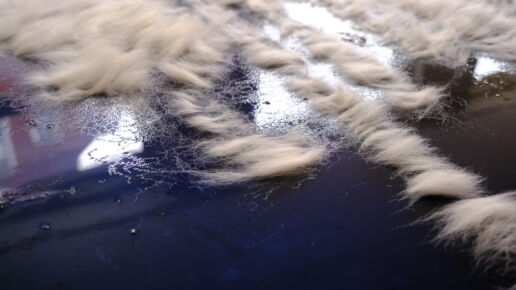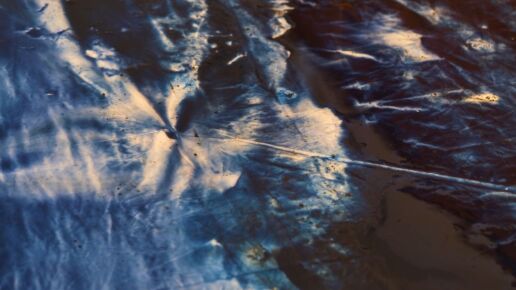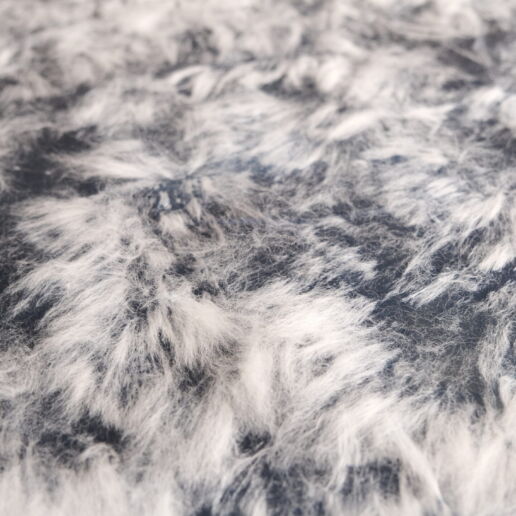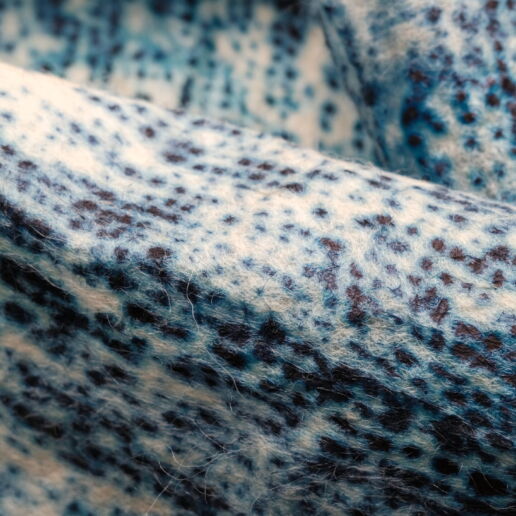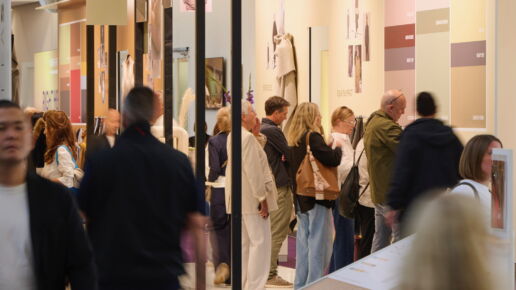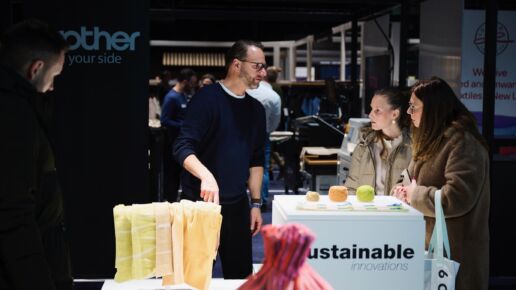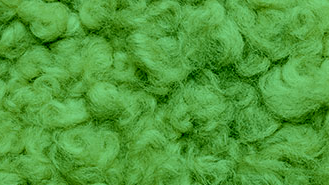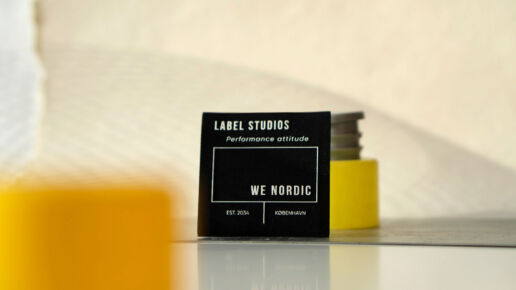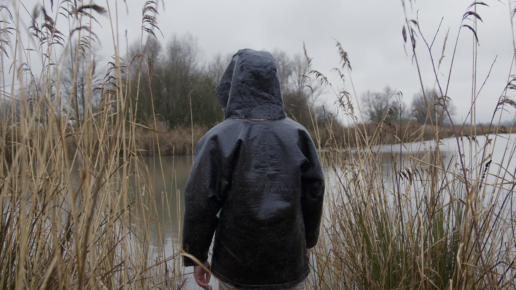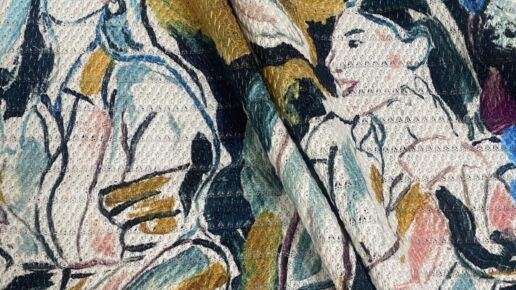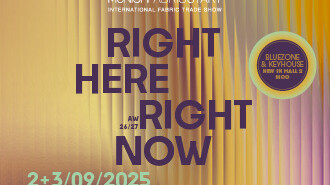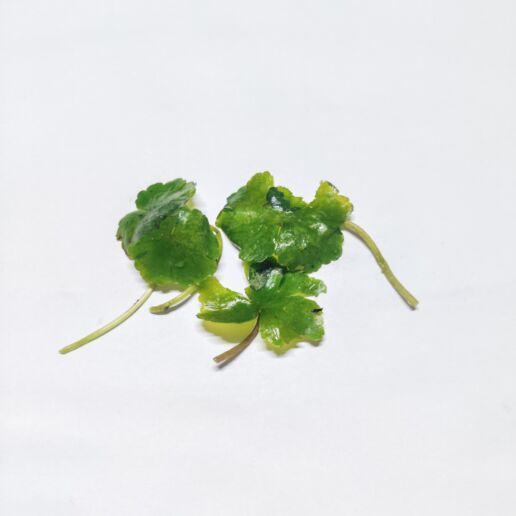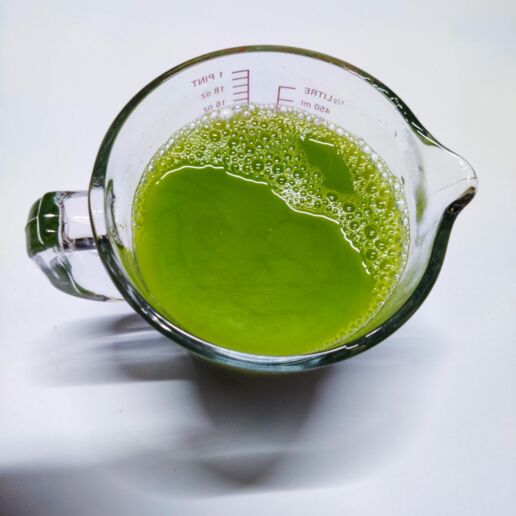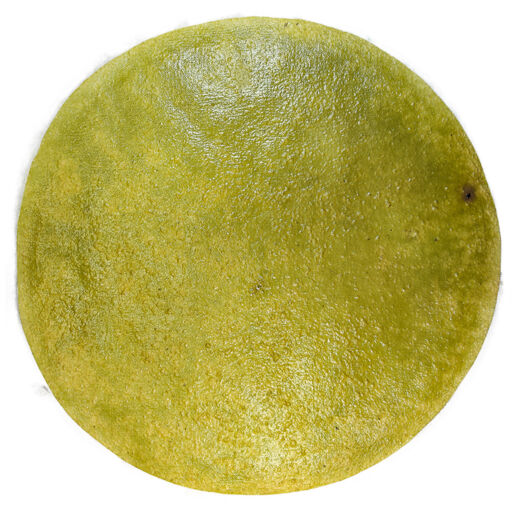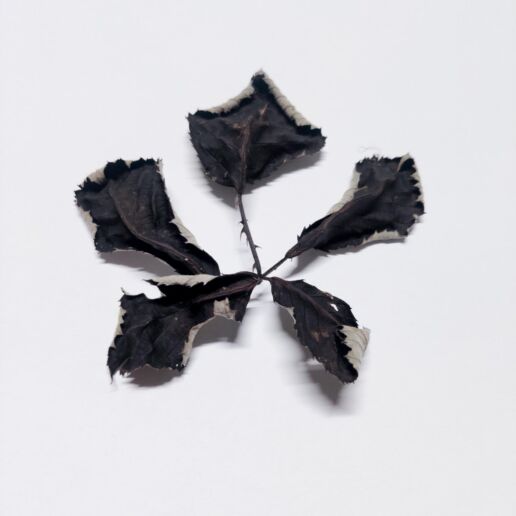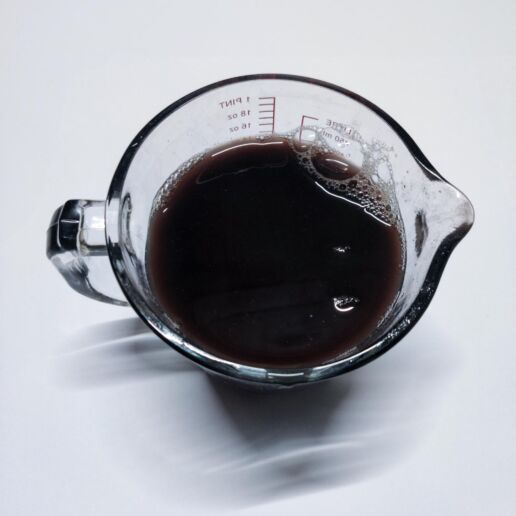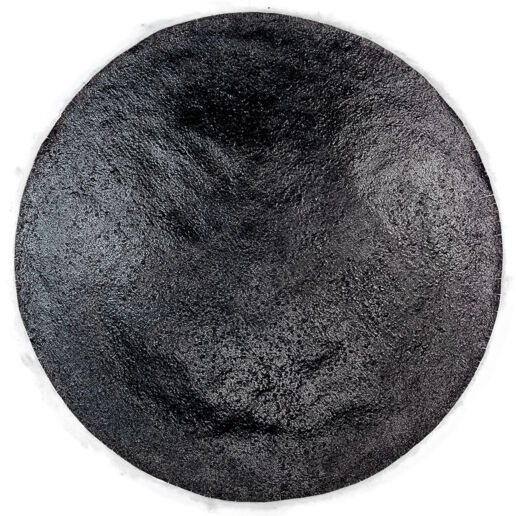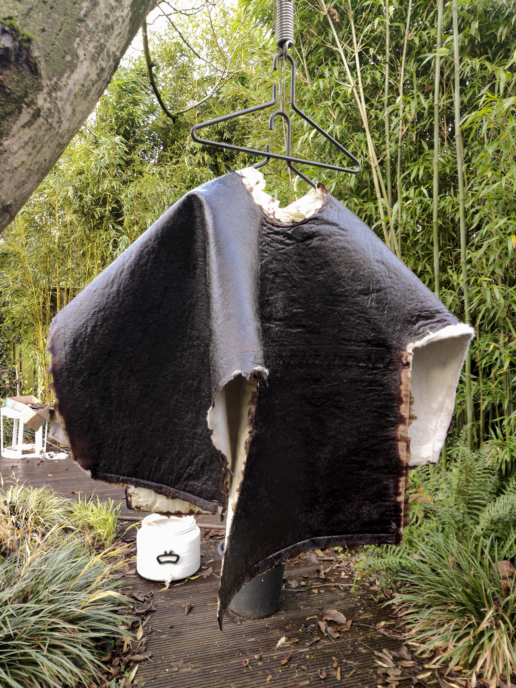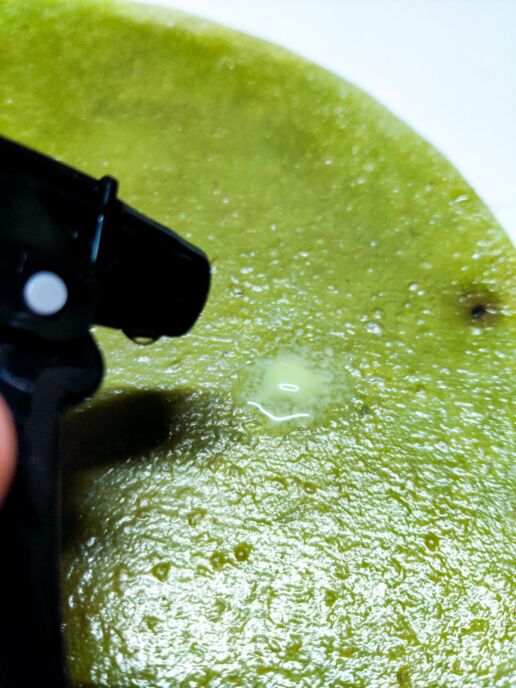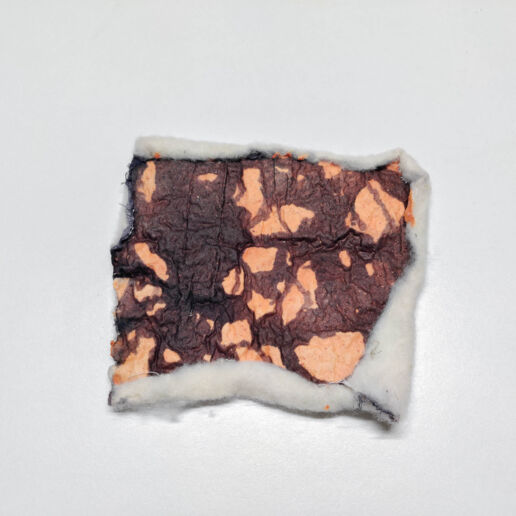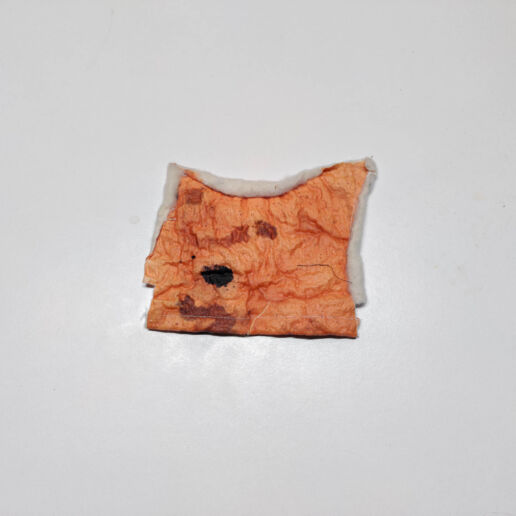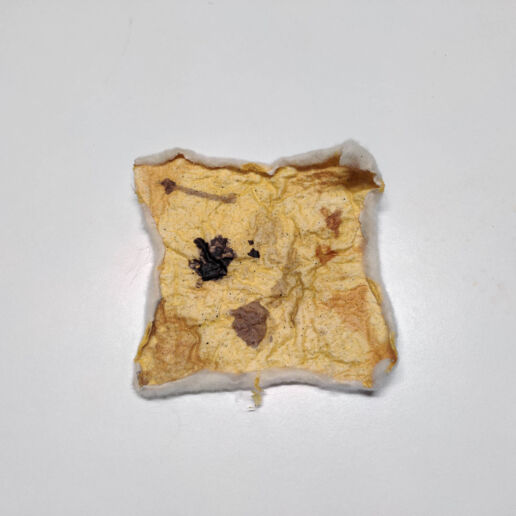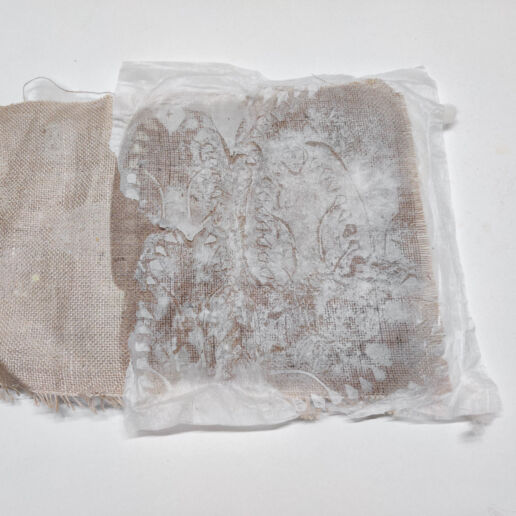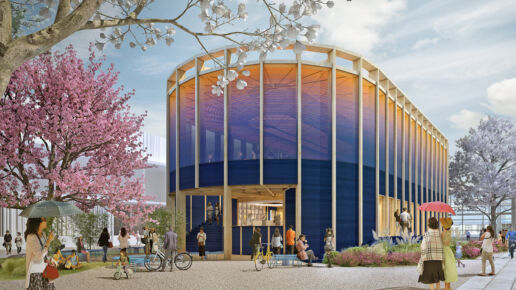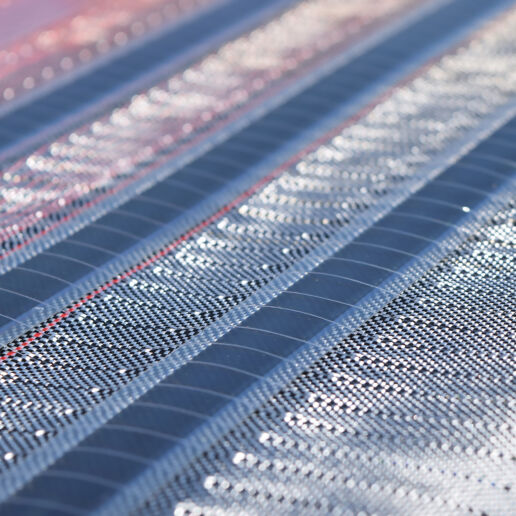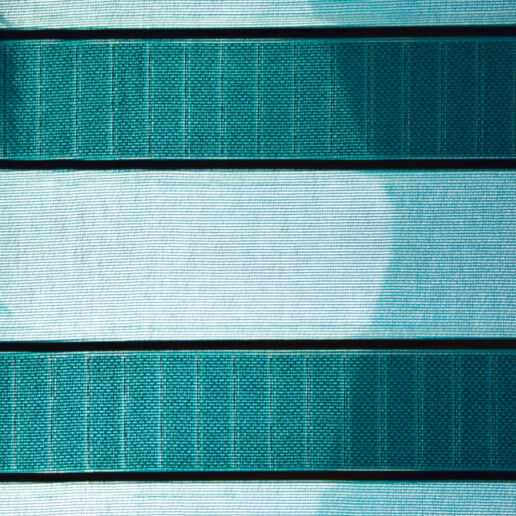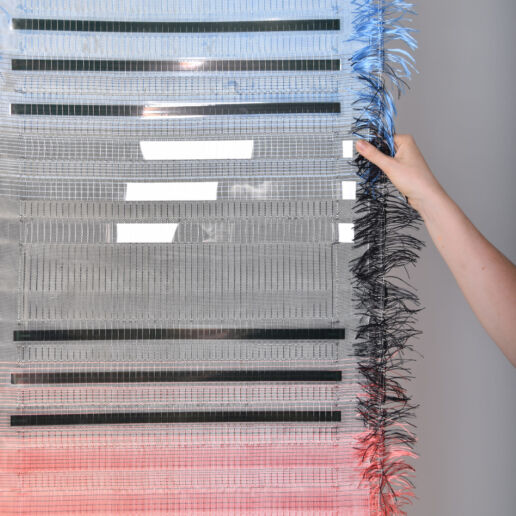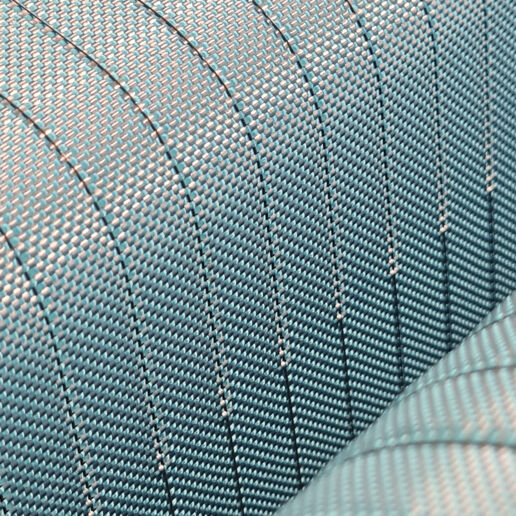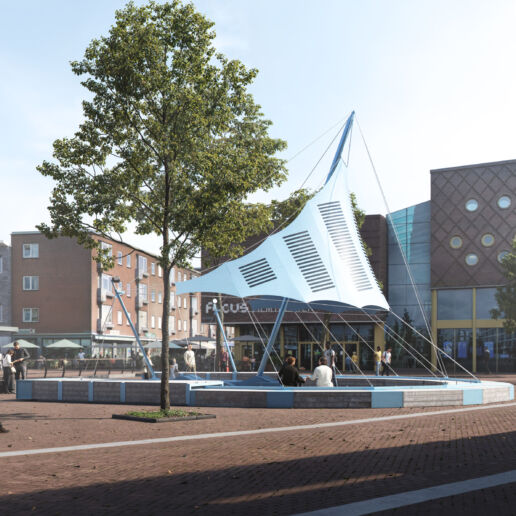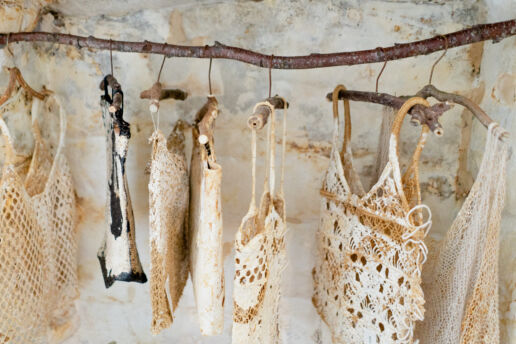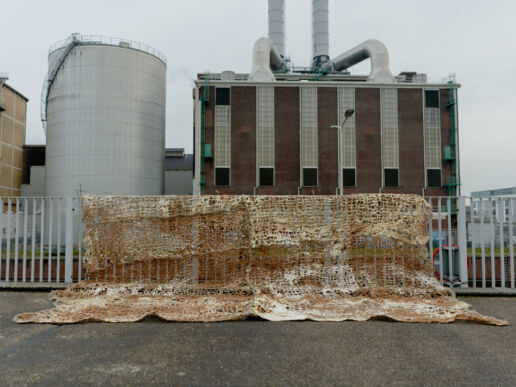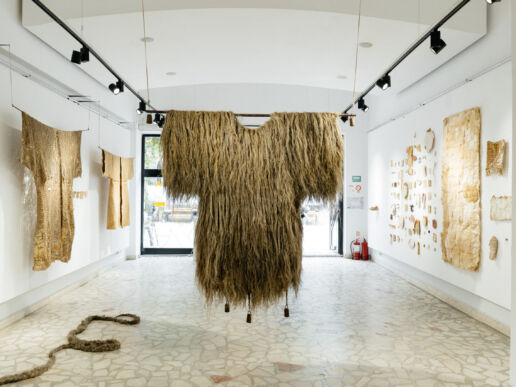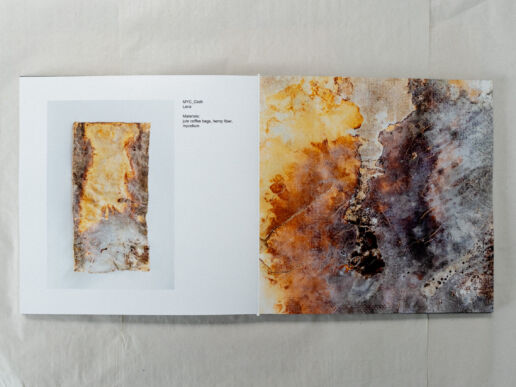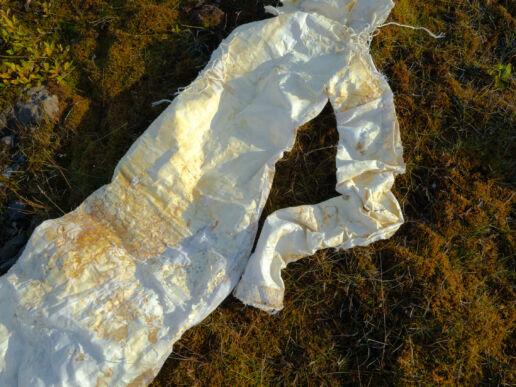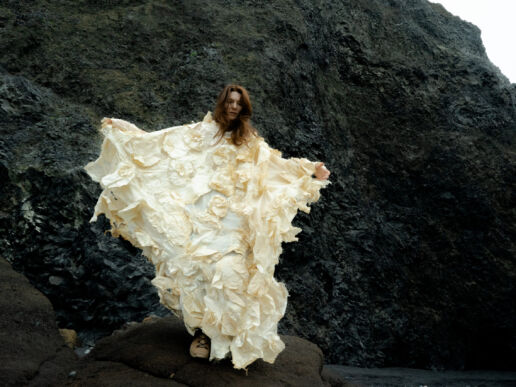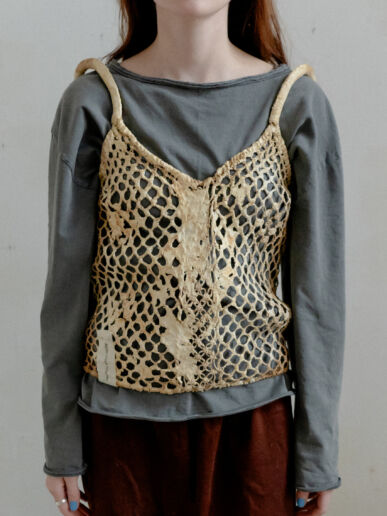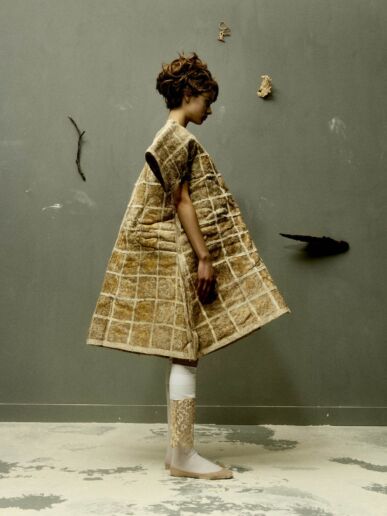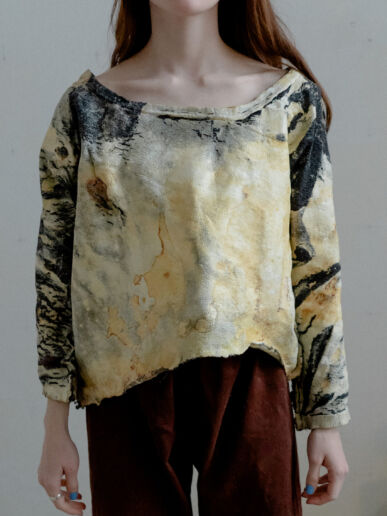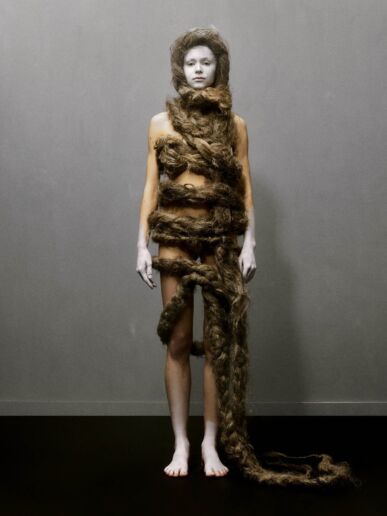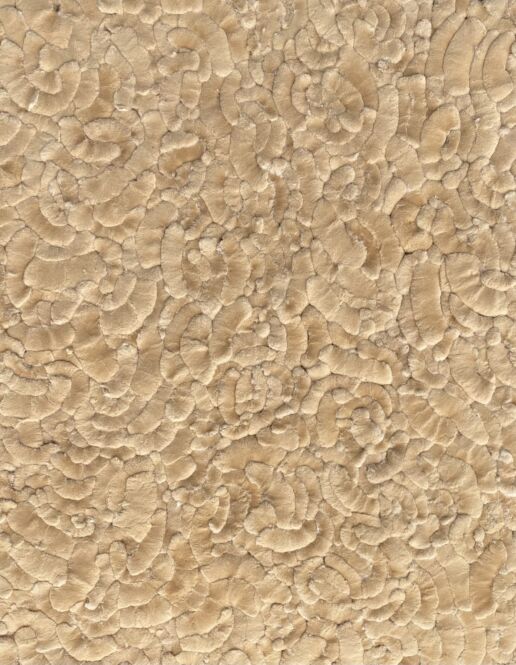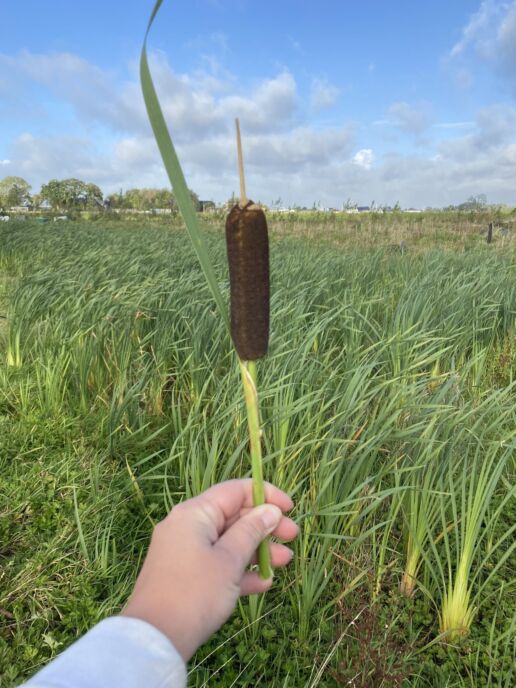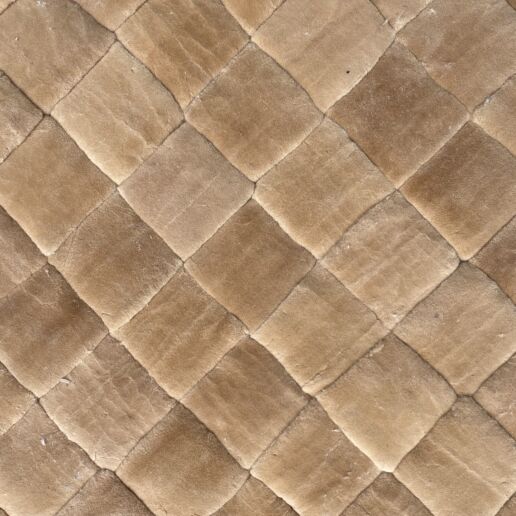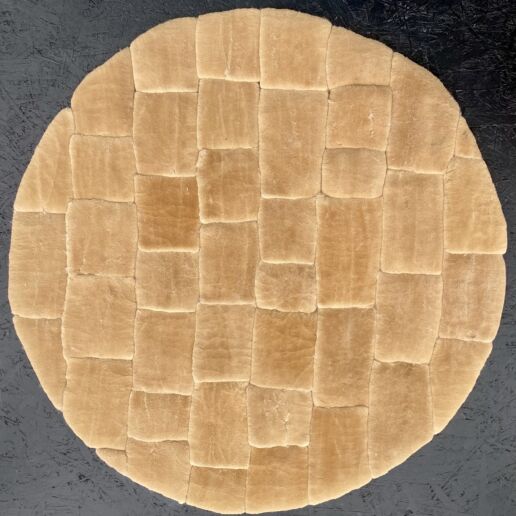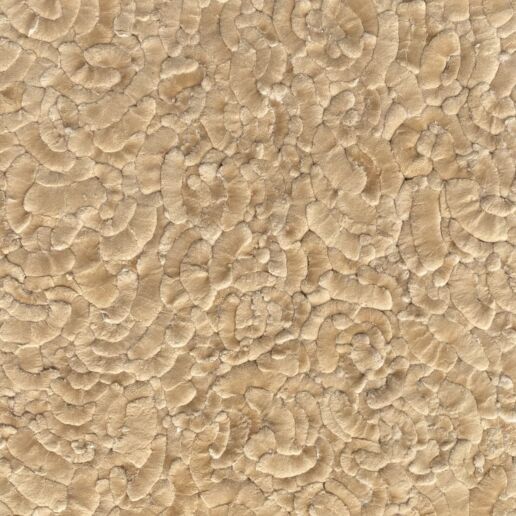Sustainability
Living Matter: Bio-Luxury for Future Materials
Luxury has always been a contradiction. It’s admired for its craft and allure, yet criticised for its excess. Living Matter takes this tension and turns it into a question: what if luxury wasn’t about being rare or exclusive, but about being responsible and creative?
Indigo, a colour with a lot of history, is the main focus of this project. Denim has always meant strength and durability, and its roughness is linked to work and usefulness. In this case, indigo is used to provoke. Biomaterials like Indigo Fur, Indigo BioLeather, and Indigo Veil change the roughness of denim into something soft, light, and impossibly elegant. These materials are made to feel high-end, but they are also made to change, age, and eventually return to the earth.
The process uses marine biopolymers, plant fibres, and even charcoal waste, which are mixed with cotton and natural indigo dyes. The results are more than just surfaces; they are shaped by techniques like folding, pleating, and fur-crafting. They feel alive, with both a scientific and a craft-like touch. Every piece tells a story about what happens when old and new come together.
“By rethinking luxury as a nature-driven, craftsmanship-based concept, the project pioneers sustainable luxury.”
Shushanik Droshakiryan
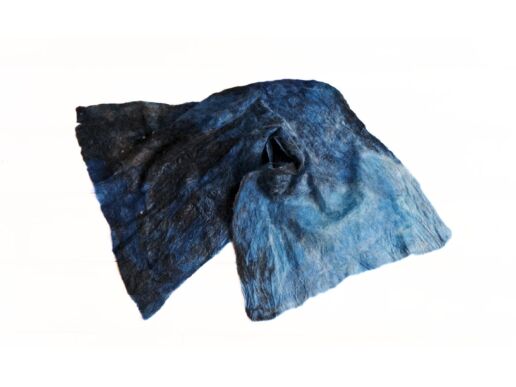
What stands out is how beautiful these materials are without any shame. Sustainable design is too often shown in muted colours, as if restraint is the only way to show responsibility. Living Matter has a different point of view. Indigo here is strong and bright, with textures that are rich, sensory, and very appealing. It doesn’t agree that taking care of the planet means giving up style.
Luxury sets the tone for the wider industry, shaping what people desire and why they engage with fashion at all. Living Matter challenges this influence, urging a shift away from extraction toward stewardship redefining bio-based materials not as compromise, but as the ultimate expression of desirability.
Presented at the September 2025 edition of Munich Fabric Start’s Sustainable Innovations forum, the project will make its case in the right place thanks to the kind collaboration with OFFICINA +39 as supplier of RECYCROMTM RTD OCEAN dye as well as EU COTTON who provided the raw cotton used in this project. Pushing boundaries and spotlighting visions of fashion’s future, it has the potential to reframe bio-based materials not as substitutes or compromises, but as the new height of aspiration.
H2 | SI
THIS MIGHT BE ALSO INTERESTING FOR YOU:
MUNICH FABRIC START – September 25 closing report
4. September 2025
At its 56th edition, MUNICH FABRIC START reinforced its clear positioning. Over two days, the Munich textile trade show brought the fashion industry together with its four show-in-show formats.
Materials as Agents of Change with Simon Angel
1. September 2025
Each season, the Sustainable Innovations forum brings together projects that provoke, inspire, and challenge assumptions. This year is no exception, with work ranging from bio-luxury couture to energy-generating textiles and regenerative materials grown from wetlands.
AUTUMN.WINTER 26/27 FABRIC HIGHLIGHTS & MATERIAL NOVELTIES – PART X
31. August 2025
For the first time in Germany, S2G XR (Style 2 Garment eXtended Reality) will present a live demo of its 3D textile configurator at booth A4.20 Not a teaser.
Living Matter: Bio-Luxury for Future Materials
31. August 2025
Indigo, a colour with a lot of history, is the main focus of this project. Denim has always meant strength and durability, and its roughness is linked to work and usefulness.
BLUEZONE NEWS FOR SEPTEMBER 2025 – PART VI
31. August 2025
At DNM Denim, the journey continues. Inspired by nature’s cycles and guided by Flow Theory, the company moves from Challenge to Focus, and now to Freedom—the phase where potential becomes power.
BIOTEXFUTURE: How to Make Textiles from Fossils
30. August 2025
The program is a group of businesses and universities working together to find scalable, bio-based alternatives.
Additionals Trends Autumn.Winter 26/27 – Part 8
30. August 2025
This collection embodies softness, simplicity, and flow – from soft-touch labels and stretchable materials that move with the body, to a calming palette of pastel tones and organic, natural fibers.
Wetlands Matters – by Marc Wijkmans
29. August 2025
Wijkman’s idea came from a simple but important observation: animals carry seeds across ecosystems in their fur.
AUTUMN.WINTER 26/27 FABRIC HIGHLIGHTS & MATERIAL NOVELTIES – PART IX
29. August 2025
The designs embrace various trend themes – sometimes subtle, sometimes expressive – and lend each fabric its own distinctive character.
MUNICH FABRIC START September 2025 – Outlook
29. August 2025
The countdown is on: in just three weeks, Munich will once againbecome the epicentre of the European fashion and textile industry. During the first week ofSeptember, MUNICH FABRIC START Exhibitions GmbH will unite all key fashion segments underone roof, reaffirming its position as one of Europe’s leading textile trade shows.
BIOTEXFUTURE: How to Make Textiles from Fossils
One of fashion’s biggest contradictions is that it relies on fossil fuels. Polyester, nylon, and acrylic make up most of the world’s fibres, which means that most clothes today start out as crude oil. adidas and RWTH Aachen University are leading the German project BIOTEXFUTURE, which wants to end that dependence.
The program is a group of businesses and universities working together to find scalable, bio-based alternatives. It is funded by the Federal Ministry of Education and Research. Part of the SUSTAINABLE INNOVATIONS forum at Munich Fabric start, three main projects will be featured:
- CircWool: a process that uses a solvent to restore wool fibres without lowering their quality.
- BioPETex: a bio-based polyester that works just as well as regular PET.
- BioCushion: a type of spacer fabric that can be recycled and used in shoes and clothes. It is both strong and circular.
These projects are not meant to be one-time tests; they are meant to be useful in the real world. Adding them to the forum ties speculative design ideas to a long history of applied science. It reminds us that we need both creativity and infrastructure to make the switch to sustainable textiles.

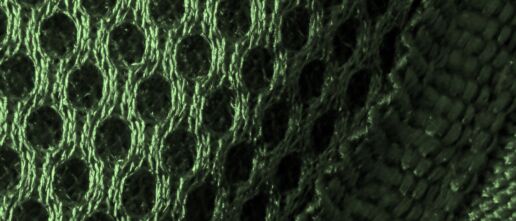
BioCushion
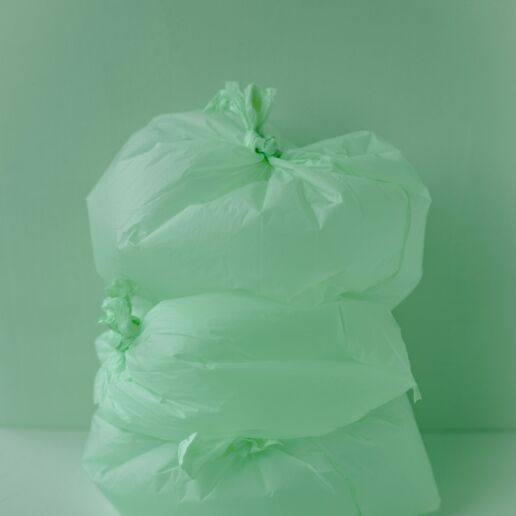
BioPEtex

BioPEtex
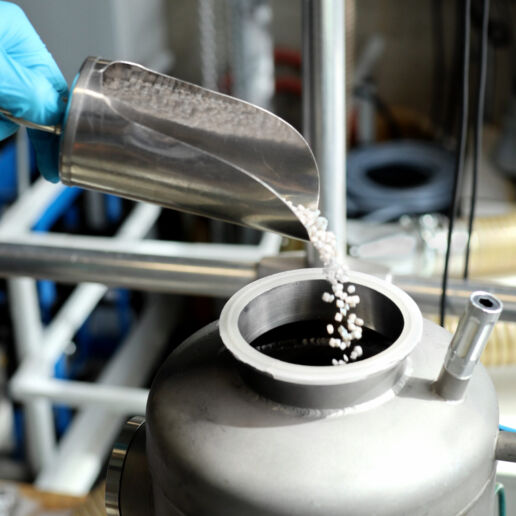
BioPEtex
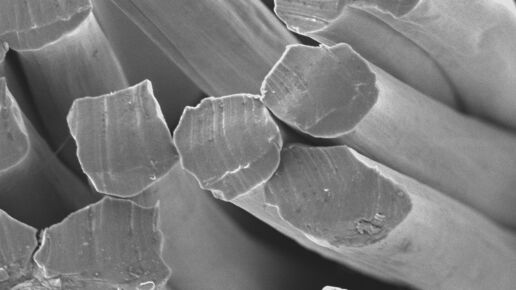
CircWool
BIOTEXFUTURE is holding the right vision to transform the textile value chain.”
adidas Future Team
The message is clear for fashion and textiles: greenwashing can’t hide the fact that we depend on oil. We need to change the way things are built, and bio-based fibres are a big part of that. The good news is that the technology is available, partnerships are forming, and interest is growing.
Petrochemistry has defined textiles for the last 100 years. But projects like BIOTEXFUTURE show that a new era is coming, one where performance, style, and scale are no longer tied to oil but to renewable innovation.
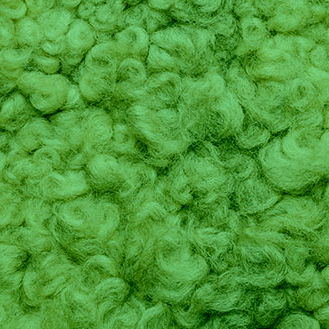
CircWool
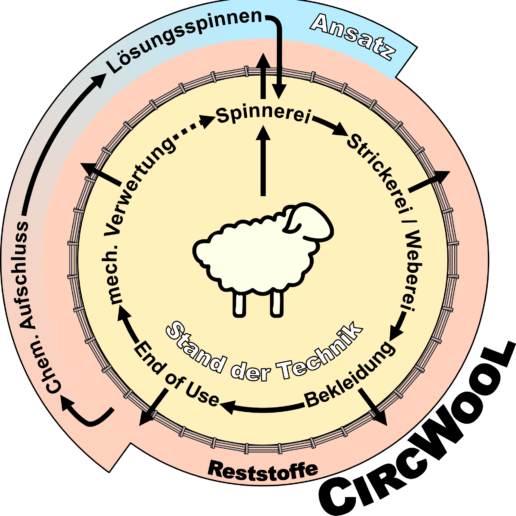
CircWool
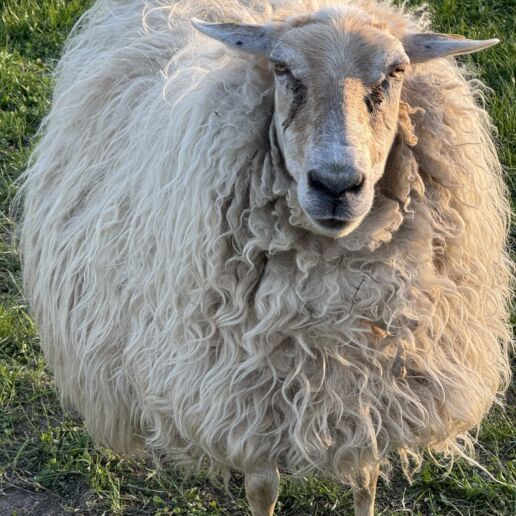
CircWool
Visit BIOTEXFUTURE H2 | SI
THIS MIGHT BE ALSO INTERESTING FOR YOU
MUNICH FABRIC START – September 25 closing report
4. September 2025
At its 56th edition, MUNICH FABRIC START reinforced its clear positioning. Over two days, the Munich textile trade show brought the fashion industry together with its four show-in-show formats.
Materials as Agents of Change with Simon Angel
1. September 2025
Each season, the Sustainable Innovations forum brings together projects that provoke, inspire, and challenge assumptions. This year is no exception, with work ranging from bio-luxury couture to energy-generating textiles and regenerative materials grown from wetlands.
AUTUMN.WINTER 26/27 FABRIC HIGHLIGHTS & MATERIAL NOVELTIES – PART X
31. August 2025
For the first time in Germany, S2G XR (Style 2 Garment eXtended Reality) will present a live demo of its 3D textile configurator at booth A4.20 Not a teaser.
Living Matter: Bio-Luxury for Future Materials
31. August 2025
Indigo, a colour with a lot of history, is the main focus of this project. Denim has always meant strength and durability, and its roughness is linked to work and usefulness.
BLUEZONE NEWS FOR SEPTEMBER 2025 – PART VI
31. August 2025
At DNM Denim, the journey continues. Inspired by nature’s cycles and guided by Flow Theory, the company moves from Challenge to Focus, and now to Freedom—the phase where potential becomes power.
BIOTEXFUTURE: How to Make Textiles from Fossils
30. August 2025
The program is a group of businesses and universities working together to find scalable, bio-based alternatives.
Additionals Trends Autumn.Winter 26/27 – Part 8
30. August 2025
This collection embodies softness, simplicity, and flow – from soft-touch labels and stretchable materials that move with the body, to a calming palette of pastel tones and organic, natural fibers.
Wetlands Matters – by Marc Wijkmans
29. August 2025
Wijkman’s idea came from a simple but important observation: animals carry seeds across ecosystems in their fur.
AUTUMN.WINTER 26/27 FABRIC HIGHLIGHTS & MATERIAL NOVELTIES – PART IX
29. August 2025
The designs embrace various trend themes – sometimes subtle, sometimes expressive – and lend each fabric its own distinctive character.
MUNICH FABRIC START September 2025 – Outlook
29. August 2025
The countdown is on: in just three weeks, Munich will once againbecome the epicentre of the European fashion and textile industry. During the first week ofSeptember, MUNICH FABRIC START Exhibitions GmbH will unite all key fashion segments underone roof, reaffirming its position as one of Europe’s leading textile trade shows.
Wetlands Matters – by Marc Wijkmans
In the Netherlands, where land and water are always at odds with each other, design often has to work with ecology. Marc Wijkmans Studio “Wetlands” takes this conversation into textiles, treating fabrics not as neutral surfaces but as active participants that can help landscapes grow.
Wijkman’s idea came from a simple but important observation: animals carry seeds across ecosystems in their fur. He made a fabric that purposely catches and spreads seeds by imitating this natural process. The material is made of wool, sodium alginate, and linseed oil, and it doesn’t have the smooth, perfect look of regular fabrics. Instead, its value comes from its flaws, how it can get stuck, carry things, and help the process of re-wilding continue. This approach goes against what people think about outdoor clothing.
“Seeds stick to fur. Building on this, I came up with the idea to give the material a fur-like surface.”
Marc Wijkmans
As most of us know, performance fabrics today are largely synthetic-engineered to be strong and water-resistant, yet infamous for shedding microplastics. Wetlands Matters challenges this conventional notion of “functionality.” Here, performance is redefined: not about keeping people dry, but about serving the ecological needs of a site.
Tested in the Hemelrijkse Waard nature reserve, the textile demonstrates that protection can be mutual – between wearer and landscape. From this emerges a clear lesson for the fashion and textile industries: materials must be rethought entirely. What if fabrics were designed to collaborate with their surroundings rather than resist them? What if impermanence and biodegradability were not flaws, but essential virtues for a sustainable future?
All in all, Wetlands Matters doesn’t say that it has a solution that is ready to sell. It works as a provocation instead: a reminder that the future of textiles may be less about how long they last and how well they work in the narrow sense and more about how they can help landscapes grow quietly and steadily.
H2 | SI
THIS MIGHT BE ALSO INTERESTING FOR YOU:
MUNICH FABRIC START – September 25 closing report
4. September 2025
At its 56th edition, MUNICH FABRIC START reinforced its clear positioning. Over two days, the Munich textile trade show brought the fashion industry together with its four show-in-show formats.
Materials as Agents of Change with Simon Angel
1. September 2025
Each season, the Sustainable Innovations forum brings together projects that provoke, inspire, and challenge assumptions. This year is no exception, with work ranging from bio-luxury couture to energy-generating textiles and regenerative materials grown from wetlands.
AUTUMN.WINTER 26/27 FABRIC HIGHLIGHTS & MATERIAL NOVELTIES – PART X
31. August 2025
For the first time in Germany, S2G XR (Style 2 Garment eXtended Reality) will present a live demo of its 3D textile configurator at booth A4.20 Not a teaser.
Living Matter: Bio-Luxury for Future Materials
31. August 2025
Indigo, a colour with a lot of history, is the main focus of this project. Denim has always meant strength and durability, and its roughness is linked to work and usefulness.
BLUEZONE NEWS FOR SEPTEMBER 2025 – PART VI
31. August 2025
At DNM Denim, the journey continues. Inspired by nature’s cycles and guided by Flow Theory, the company moves from Challenge to Focus, and now to Freedom—the phase where potential becomes power.
BIOTEXFUTURE: How to Make Textiles from Fossils
30. August 2025
The program is a group of businesses and universities working together to find scalable, bio-based alternatives.
Additionals Trends Autumn.Winter 26/27 – Part 8
30. August 2025
This collection embodies softness, simplicity, and flow – from soft-touch labels and stretchable materials that move with the body, to a calming palette of pastel tones and organic, natural fibers.
Wetlands Matters – by Marc Wijkmans
29. August 2025
Wijkman’s idea came from a simple but important observation: animals carry seeds across ecosystems in their fur.
AUTUMN.WINTER 26/27 FABRIC HIGHLIGHTS & MATERIAL NOVELTIES – PART IX
29. August 2025
The designs embrace various trend themes – sometimes subtle, sometimes expressive – and lend each fabric its own distinctive character.
MUNICH FABRIC START September 2025 – Outlook
29. August 2025
The countdown is on: in just three weeks, Munich will once againbecome the epicentre of the European fashion and textile industry. During the first week ofSeptember, MUNICH FABRIC START Exhibitions GmbH will unite all key fashion segments underone roof, reaffirming its position as one of Europe’s leading textile trade shows.
Heliotex – Studio Pauline van Dongen
Textiles have always covered our bodies, but what if they could also power the things around us? Heliotex (formerly known as Suntex), from designer Pauline van Dongen, is a challenge to what people think fabric can do.
Heliotex is basically a way to combine organic photovoltaics with lightweight, flexible fabrics. The result is sunshades and canopies that generate energy and look good at the same time. These fabrics move, fold, and breathe with their surroundings, unlike rigid solar panels. They think of renewable energy not as something that needs to be hidden away, but as something that is beautiful, soft, and fits in perfectly with the rest of the world.
“We focus on outdoor applications like textile facades, festival tents, and shade structures… Of course, we also foresee indoor applications like curtains and sun shading.”
Pauline van Dongen
The fact that Simon Angel included the project in this season’s SUSTAINABLE INNOVATIONS forum puts it in a bigger story: textiles are no longer passive. They are tools for making big changes in the system. Heliotex shows how fabrics can go beyond traditional categories by working at the intersection of design, architecture, and energy. It is similar to Wetlands Matters and Plantfur.
The effects of van Dongen’s work on the fashion and textile industries will be huge. The textile industry can grow if textiles can collect energy. Sustainability stops being about doing less harm and starts being about giving more value, like comfort, beauty, and clean energy all at once.
The lesson is practical but lofty: sustainability should feel like a part of everyday life, not something that is added on. Heliotex shows that renewable energy can be touchable, welcoming, and even luxurious. This is a call for people who work in fashion and textiles to think of fabrics not just as things we wear, but also as the buildings we live in.
H2 | SI
THIS MIGHT BE ALSO INTERESTING FOR YOU:
MUNICH FABRIC START – September 25 closing report
4. September 2025
At its 56th edition, MUNICH FABRIC START reinforced its clear positioning. Over two days, the Munich textile trade show brought the fashion industry together with its four show-in-show formats.
Materials as Agents of Change with Simon Angel
1. September 2025
Each season, the Sustainable Innovations forum brings together projects that provoke, inspire, and challenge assumptions. This year is no exception, with work ranging from bio-luxury couture to energy-generating textiles and regenerative materials grown from wetlands.
AUTUMN.WINTER 26/27 FABRIC HIGHLIGHTS & MATERIAL NOVELTIES – PART X
31. August 2025
For the first time in Germany, S2G XR (Style 2 Garment eXtended Reality) will present a live demo of its 3D textile configurator at booth A4.20 Not a teaser.
Living Matter: Bio-Luxury for Future Materials
31. August 2025
Indigo, a colour with a lot of history, is the main focus of this project. Denim has always meant strength and durability, and its roughness is linked to work and usefulness.
BLUEZONE NEWS FOR SEPTEMBER 2025 – PART VI
31. August 2025
At DNM Denim, the journey continues. Inspired by nature’s cycles and guided by Flow Theory, the company moves from Challenge to Focus, and now to Freedom—the phase where potential becomes power.
BIOTEXFUTURE: How to Make Textiles from Fossils
30. August 2025
The program is a group of businesses and universities working together to find scalable, bio-based alternatives.
Additionals Trends Autumn.Winter 26/27 – Part 8
30. August 2025
This collection embodies softness, simplicity, and flow – from soft-touch labels and stretchable materials that move with the body, to a calming palette of pastel tones and organic, natural fibers.
Wetlands Matters – by Marc Wijkmans
29. August 2025
Wijkman’s idea came from a simple but important observation: animals carry seeds across ecosystems in their fur.
AUTUMN.WINTER 26/27 FABRIC HIGHLIGHTS & MATERIAL NOVELTIES – PART IX
29. August 2025
The designs embrace various trend themes – sometimes subtle, sometimes expressive – and lend each fabric its own distinctive character.
MUNICH FABRIC START September 2025 – Outlook
29. August 2025
The countdown is on: in just three weeks, Munich will once againbecome the epicentre of the European fashion and textile industry. During the first week ofSeptember, MUNICH FABRIC START Exhibitions GmbH will unite all key fashion segments underone roof, reaffirming its position as one of Europe’s leading textile trade shows.
Atelier Dasha Tsapenko's MYC_Couture
People have long praised couture for its ability to shock. But what if fashion didn’t just shock people with its looks but also made them think about what it was made of? Atelier Dasha Tsapenko’s ongoing project, MYC_Couture, is based on that idea. Instead of making clothes, she grows them.
Tsapenko has made clothes out of fungi, hemp, and flax; living collaborations between the designer and the organism. The coats and gowns that came out of this unusual partnership are dramatic and sculptural. They look like couture fantasy, but their biology is what makes them new. The garments grow back, break down, and eventually go back to the earth. Tsapenko has introduced the new idea of “bioluxury”, which is a model that accepts change and that things don’t last, instead of fighting against change.
“Textures and materials are not produced; they grow.”
Dasha Tsapenko
This vision is not a gimmick or a small test. MYC_Couture, understands that a shift in worldview from garments as static objects to garments as part of ecological cycles isn’t about keeping things the same, it’s about celebrating change, growth, and coming back.
No stranger to events like Dutch Design Week, Copenhagen Fashion Week, and now at Munich Fabric Start, you will find MYC_Couture housed in the SUSTAINABLE INNOVATIONS space. There she hopes to start a conversation about changing the way fashion and ecology are connected. Her lesson is both simple and radical: sustainability cannot be achieved by efficiency tweaks alone.
H2 | SI
THIS MIGHT BE ALSO INTERESTING FOR YOU:
MUNICH FABRIC START – September 25 closing report
4. September 2025
At its 56th edition, MUNICH FABRIC START reinforced its clear positioning. Over two days, the Munich textile trade show brought the fashion industry together with its four show-in-show formats.
Materials as Agents of Change with Simon Angel
1. September 2025
Each season, the Sustainable Innovations forum brings together projects that provoke, inspire, and challenge assumptions. This year is no exception, with work ranging from bio-luxury couture to energy-generating textiles and regenerative materials grown from wetlands.
AUTUMN.WINTER 26/27 FABRIC HIGHLIGHTS & MATERIAL NOVELTIES – PART X
31. August 2025
For the first time in Germany, S2G XR (Style 2 Garment eXtended Reality) will present a live demo of its 3D textile configurator at booth A4.20 Not a teaser.
Living Matter: Bio-Luxury for Future Materials
31. August 2025
Indigo, a colour with a lot of history, is the main focus of this project. Denim has always meant strength and durability, and its roughness is linked to work and usefulness.
BLUEZONE NEWS FOR SEPTEMBER 2025 – PART VI
31. August 2025
At DNM Denim, the journey continues. Inspired by nature’s cycles and guided by Flow Theory, the company moves from Challenge to Focus, and now to Freedom—the phase where potential becomes power.
BIOTEXFUTURE: How to Make Textiles from Fossils
30. August 2025
The program is a group of businesses and universities working together to find scalable, bio-based alternatives.
Additionals Trends Autumn.Winter 26/27 – Part 8
30. August 2025
This collection embodies softness, simplicity, and flow – from soft-touch labels and stretchable materials that move with the body, to a calming palette of pastel tones and organic, natural fibers.
Wetlands Matters – by Marc Wijkmans
29. August 2025
Wijkman’s idea came from a simple but important observation: animals carry seeds across ecosystems in their fur.
AUTUMN.WINTER 26/27 FABRIC HIGHLIGHTS & MATERIAL NOVELTIES – PART IX
29. August 2025
The designs embrace various trend themes – sometimes subtle, sometimes expressive – and lend each fabric its own distinctive character.
MUNICH FABRIC START September 2025 – Outlook
29. August 2025
The countdown is on: in just three weeks, Munich will once againbecome the epicentre of the European fashion and textile industry. During the first week ofSeptember, MUNICH FABRIC START Exhibitions GmbH will unite all key fashion segments underone roof, reaffirming its position as one of Europe’s leading textile trade shows.
Plantfur – by Studio iFOCUS
Peatlands, which are often called the “lungs of the earth,”, are delicate ecosystems that are under a lot of stress. These carbon-rich soils in the Netherlands are at risk of collapsing because of centuries of draining and intensive farming. When they do, they release emissions into the air. This environmental crisis is not only a call to fix things, for designer Iris Veentjer; it is also a chance to rethink the future of materials.
Veentjer’s practice has turned her attention to cattails, a plant that grows well in waterlogged soils and has the potential to change both landscapes and textiles. Plantfur, a surface material made from the cigar-shaped seed heads of the cattail, is the main focus of this research. These spikes are usually thrown away as agricultural waste, but they are collected before they spread too much and turned into panels that look like fur. Each cigar has its own size, so when they are put together, they make striated surfaces that are naturally beautiful. Not only is the material a more environmentally friendly alternative to animal fur and petroleum-based synthetics, but it also gives farmers a crop that helps reduce emissions.
“Harvesting cattail cigars earlier prevents their invasive spread and transforms waste into value.”
Iris Veentjer
The fact that SUSTAINABLE INNOVATIONS forum is featuring the project this season shows how important it is. Plantfur shows that sustainability can mean more than just doing less harm. Plantfur makes important points for the fashion and textile industries. What if wetlands were used to grow fur instead of factory farms? What if farming worked with climate resilience instead of against it?
Plantfur doesn’t just replace old materials; it makes a new way to use them based on ecological reciprocity. This is a very important lesson to learn. People won’t just judge the textiles of the future by how they feel on the skin; they’ll also judge them by how they work in ecosystems. Veentjer’s work shows that luxury and sustainability don’t have to be at odds with each other. They can be redefined together with materials that are both beautiful and good for the environment.
H2 | SI
THIS MIGHT BE ALSO INTERESTING FOR YOU:
MUNICH FABRIC START – September 25 closing report
4. September 2025
At its 56th edition, MUNICH FABRIC START reinforced its clear positioning. Over two days, the Munich textile trade show brought the fashion industry together with its four show-in-show formats.
Materials as Agents of Change with Simon Angel
1. September 2025
Each season, the Sustainable Innovations forum brings together projects that provoke, inspire, and challenge assumptions. This year is no exception, with work ranging from bio-luxury couture to energy-generating textiles and regenerative materials grown from wetlands.
AUTUMN.WINTER 26/27 FABRIC HIGHLIGHTS & MATERIAL NOVELTIES – PART X
31. August 2025
For the first time in Germany, S2G XR (Style 2 Garment eXtended Reality) will present a live demo of its 3D textile configurator at booth A4.20 Not a teaser.
Living Matter: Bio-Luxury for Future Materials
31. August 2025
Indigo, a colour with a lot of history, is the main focus of this project. Denim has always meant strength and durability, and its roughness is linked to work and usefulness.
BLUEZONE NEWS FOR SEPTEMBER 2025 – PART VI
31. August 2025
At DNM Denim, the journey continues. Inspired by nature’s cycles and guided by Flow Theory, the company moves from Challenge to Focus, and now to Freedom—the phase where potential becomes power.
BIOTEXFUTURE: How to Make Textiles from Fossils
30. August 2025
The program is a group of businesses and universities working together to find scalable, bio-based alternatives.
Additionals Trends Autumn.Winter 26/27 – Part 8
30. August 2025
This collection embodies softness, simplicity, and flow – from soft-touch labels and stretchable materials that move with the body, to a calming palette of pastel tones and organic, natural fibers.
Wetlands Matters – by Marc Wijkmans
29. August 2025
Wijkman’s idea came from a simple but important observation: animals carry seeds across ecosystems in their fur.
AUTUMN.WINTER 26/27 FABRIC HIGHLIGHTS & MATERIAL NOVELTIES – PART IX
29. August 2025
The designs embrace various trend themes – sometimes subtle, sometimes expressive – and lend each fabric its own distinctive character.
MUNICH FABRIC START September 2025 – Outlook
29. August 2025
The countdown is on: in just three weeks, Munich will once againbecome the epicentre of the European fashion and textile industry. During the first week ofSeptember, MUNICH FABRIC START Exhibitions GmbH will unite all key fashion segments underone roof, reaffirming its position as one of Europe’s leading textile trade shows.
ReSOURCE NEWS: KOMBINAT KONOPNY
The ReSOURCE area at MUNICH FABRIC START is the sourcing platform for environmentally friendly and responsibly produced textiles, clothing and accessories. Search, discover and procure – all in one place. Order sustainable materials online at any time at www.resource-textiles.com.
With around 500 samples, the area for innovative Fabrics and Additionals that are bio-certified, bio-based, recycled, recyclable or from regenerative sources has once again grown significantly compared to previous seasons.
What is KOMBINAT?
KOMBINAT is an idea. This idea is centered around a group of enthusiasts who have set themselves the crazy goal of bringing hemp materials back into the textile mainstream. Why? Because we believe in practical solutions, solid craftsmanship, and that in today’s world, it’s still possible to do things your own way, going against the current.
Hemp fiber has been out of circulation for a long time – in our opinion, far too long. We also believe that the world simply needs a healthy counterbalance to the omnipresent plastic, the flood of junk, and the fast-fashion movement, which, to put it mildly, is not our cup of tea.
Our philosophy is balance – we are aware that we will never be perfect, one hundred percent ecological, and satisfying absolutely everyone’s needs – we’re not tomato soup to fit everyone’s taste (if you don’t like tomato soup – substitute any other soup here) – we know that our activities won’t save the entire world, and that’s not our goal either.
A sustainable approach, balance without going to extremes is something that defines us well.
“If these values resonate with you – welcome aboard. We believe hemp is a great raw material and we want it to become a natural choice again. Just like it used to be.” – Maciej Kowalski


Why hemp?
Because it works. It’s strong and breathable. Clothes made from it have excellent thermoregulatory properties… or in human terms – they “breathe”.
Hemp is a fascinating plant – it’s not without reason that it’s colloquially called a “weed”; it doesn’t need pesticides, excellent soil, and conditions to grow several meters tall. From its fibers, you can create a material that doesn’t need to prove its value – that has been repeatedly tested in battle throughout our history, both literally and figuratively. Our products not only look good but also don’t wear out after one season. Our clothes are an investment, not a seasonal disposable.
Hemp fiber is a raw material that doesn’t require intensive chemical processing. It grows quickly, doesn’t deplete the soil, and provides us with a material that is naturally resistant to fungi and moisture. This natural fiber is also bacteriostatic – it doesn’t promote bacterial
growth.
In a nutshell: hemp textiles are durable, hygienic, and breathable.
THIS MIGHT BE ALSO INTERESTING FOR YOU
MUNICH FABRIC START – September 25 closing report
4. September 2025
At its 56th edition, MUNICH FABRIC START reinforced its clear positioning. Over two days, the Munich textile trade show brought the fashion industry together with its four show-in-show formats.
Materials as Agents of Change with Simon Angel
1. September 2025
Each season, the Sustainable Innovations forum brings together projects that provoke, inspire, and challenge assumptions. This year is no exception, with work ranging from bio-luxury couture to energy-generating textiles and regenerative materials grown from wetlands.
AUTUMN.WINTER 26/27 FABRIC HIGHLIGHTS & MATERIAL NOVELTIES – PART X
31. August 2025
For the first time in Germany, S2G XR (Style 2 Garment eXtended Reality) will present a live demo of its 3D textile configurator at booth A4.20 Not a teaser.
Living Matter: Bio-Luxury for Future Materials
31. August 2025
Indigo, a colour with a lot of history, is the main focus of this project. Denim has always meant strength and durability, and its roughness is linked to work and usefulness.
BLUEZONE NEWS FOR SEPTEMBER 2025 – PART VI
31. August 2025
At DNM Denim, the journey continues. Inspired by nature’s cycles and guided by Flow Theory, the company moves from Challenge to Focus, and now to Freedom—the phase where potential becomes power.
BIOTEXFUTURE: How to Make Textiles from Fossils
30. August 2025
The program is a group of businesses and universities working together to find scalable, bio-based alternatives.
Additionals Trends Autumn.Winter 26/27 – Part 8
30. August 2025
This collection embodies softness, simplicity, and flow – from soft-touch labels and stretchable materials that move with the body, to a calming palette of pastel tones and organic, natural fibers.
Wetlands Matters – by Marc Wijkmans
29. August 2025
Wijkman’s idea came from a simple but important observation: animals carry seeds across ecosystems in their fur.
AUTUMN.WINTER 26/27 FABRIC HIGHLIGHTS & MATERIAL NOVELTIES – PART IX
29. August 2025
The designs embrace various trend themes – sometimes subtle, sometimes expressive – and lend each fabric its own distinctive character.
MUNICH FABRIC START September 2025 – Outlook
29. August 2025
The countdown is on: in just three weeks, Munich will once againbecome the epicentre of the European fashion and textile industry. During the first week ofSeptember, MUNICH FABRIC START Exhibitions GmbH will unite all key fashion segments underone roof, reaffirming its position as one of Europe’s leading textile trade shows.
The Power of Data: Understanding How Data Tackles Challenges in the Textile Industry
The Power of Data:
Understanding How Data Tackles Challenges in the Textile Industry
by Muchaneta ten Napel
Data might feel intimidating for the fashion and textile industry, but it holds the power to unlock transparency, boost efficiency, and spark innovation. Traci Kinden, Director at TEXroad Foundation, shares her insights in an interview with Muchaneta ten Napel from Shape Innovate on how small, strategic steps and collaboration can transform data into a force for positive change.
Muchaneta: Let’s start with the big question: why does data seem so intimidating to people in the textile industry?
Traci: Data is such a small word with immense meaning, and everyone interprets it differently. If you don’t see yourself as a “numbers person,” it can feel overwhelming and even scary. A lot of the fear stems from misconceptions about what data is and how it can be used. But I’m determined to change that perspective and show that data can be accessible – and even exciting!
Muchaneta: That’s a great goal. Can you explain what TEXroad does with data to bridge these gaps?
Traci: At TEXroad, we work primarily in post-consumer textile flows. We partner with municipalities and their collection and sorting teams to gather data at every stage – collection, sorting, and processing. This data allows us to evaluate how systems are performing and measure the impact of changes over time. Additionally, we’re involved in EU-funded projects, like PESCO Up, where we develop minimum data requirements for textile recycling chains. Our goal is to make data a shared, standardized language that benefits the entire value chain.
Muchaneta: Speaking of EU-funded projects, what ensures the longevity of such initiatives after their official end?
Traci: EU-funded projects have defined start and end dates, but we strive to make their outcomes scalable and sustainable. For example, in PESCO Up, we’ve developed minimum data requirements for the recycling chain. These are shared across multiple projects to ensure consistency and long-term use. At TEXroad, we also focus on publishing non-sensitive datasets for open access, so the insights remain available to the industry even after the projects conclude.


Muchaneta: What are some of the biggest challenges you’ve faced in promoting data sharing and collaboration?
Traci: One major challenge is the lack of standardization in the industry. For instance, terms like “post-industrial waste” and “pre-consumer waste” are often used interchangeably, leading to confusion. Another hurdle is companies’ hesitancy to share data due to fears of exposing sensitive information. Building trust takes time – our sales cycles can span 12 to 24 months before concrete agreements are made.
Muchaneta: Do you think legislation could help push businesses to share and use data more effectively?
Traci: Legislation has potential, but it needs to be well-designed and adaptable to market realities. It’s crucial for businesses to align their data strategies with their priorities, whether it’s compliance with legislation or operational improvements. Taking small, strategic steps – like understanding what data you have and identifying gaps – can make navigating new policies manageable.
Muchaneta: Can you share a success story where data made a tangible impact?
Traci: Absolutely. I worked with a Dutch textile preprocessor that significantly reduced its material rejection rate – from 25–30% to under 5% – by using data to communicate clear expectations to suppliers. This kind of progress demonstrates how even small-scale data applications can lead to systemic improvements.
“At TEXroad, we aim to answer the “stupid” questions – like how much post-consumer textile waste exists – so businesses can focus on the smarter ones. By improving data quality and accessibility, we’re helping the industry take meaningful steps toward circularity and sustainability.” – Traci Kinden, TEXroad Director
Muchaneta: Transparency is a recurring theme. Why is it so important?
Traci: Transparency builds trust. For instance, many people hesitate to use textile collection bins because they don’t know where their clothing ends up. Data can illuminate these processes, giving people confidence in systems like extended producer responsibility (EPR) schemes. Transparency also enables companies to evaluate their impact and make informed decisions.
Muchaneta: What excites you most about the future of textile data?
Traci: The potential to transform the industry excites me. Better data can level the playing field for SMEs, drive innovation, and address global issues like waste mismanagement. The possibilities are endless if we can improve data quality, accessibility, and speed.
Muchaneta: Finally, what role does TEXroad play in this transformation?
Traci: At TEXroad, we aim to answer the “stupid” questions – like how much post-consumer textile waste exists – so businesses can focus on the smarter ones. By improving data quality and accessibility, we’re helping the industry take meaningful steps toward circularity and sustainability.

Follow along on TEXroad’s journey on data as a key for material use and lifecycle. Learn more on TEXroad’s mission here.
THIS MIGHT BE ALSO INTERESTING FOR YOU
MUNICH FABRIC START – September 25 closing report
4. September 2025
At its 56th edition, MUNICH FABRIC START reinforced its clear positioning. Over two days, the Munich textile trade show brought the fashion industry together with its four show-in-show formats.
Materials as Agents of Change with Simon Angel
1. September 2025
Each season, the Sustainable Innovations forum brings together projects that provoke, inspire, and challenge assumptions. This year is no exception, with work ranging from bio-luxury couture to energy-generating textiles and regenerative materials grown from wetlands.
AUTUMN.WINTER 26/27 FABRIC HIGHLIGHTS & MATERIAL NOVELTIES – PART X
31. August 2025
For the first time in Germany, S2G XR (Style 2 Garment eXtended Reality) will present a live demo of its 3D textile configurator at booth A4.20 Not a teaser.
Living Matter: Bio-Luxury for Future Materials
31. August 2025
Indigo, a colour with a lot of history, is the main focus of this project. Denim has always meant strength and durability, and its roughness is linked to work and usefulness.
BLUEZONE NEWS FOR SEPTEMBER 2025 – PART VI
31. August 2025
At DNM Denim, the journey continues. Inspired by nature’s cycles and guided by Flow Theory, the company moves from Challenge to Focus, and now to Freedom—the phase where potential becomes power.
BIOTEXFUTURE: How to Make Textiles from Fossils
30. August 2025
The program is a group of businesses and universities working together to find scalable, bio-based alternatives.
Additionals Trends Autumn.Winter 26/27 – Part 8
30. August 2025
This collection embodies softness, simplicity, and flow – from soft-touch labels and stretchable materials that move with the body, to a calming palette of pastel tones and organic, natural fibers.
Wetlands Matters – by Marc Wijkmans
29. August 2025
Wijkman’s idea came from a simple but important observation: animals carry seeds across ecosystems in their fur.
AUTUMN.WINTER 26/27 FABRIC HIGHLIGHTS & MATERIAL NOVELTIES – PART IX
29. August 2025
The designs embrace various trend themes – sometimes subtle, sometimes expressive – and lend each fabric its own distinctive character.
MUNICH FABRIC START September 2025 – Outlook
29. August 2025
The countdown is on: in just three weeks, Munich will once againbecome the epicentre of the European fashion and textile industry. During the first week ofSeptember, MUNICH FABRIC START Exhibitions GmbH will unite all key fashion segments underone roof, reaffirming its position as one of Europe’s leading textile trade shows.
KEYHOUSE NEWS - FASERKREISLAUF
In the atmospheric industrial charm of KEYHOUSE, Hall 7, progressive suppliers and global players from cross-industry sectors will be showcasing their latest new developments and innovations. On over 1,000 square metres, you will find trend-setting future fabrics and new process technologies – be it in terms of sustainability, circular economy, digitalisation & AI, traceability, textile dyeing or finishing. Staged as an interactive think tank, future-oriented show cases will be in the spotlight alongside sustainable innovations.
KEYHOUSE is also home to the main lecture forum of MUNICH FABRIC START with exclusive keynotes, panel discussions, trend presentations, Q&A sessions & expert talks by international industry insiders. Be inspired by the wide range of events at KEYHOUSE.
The Textile Revolution Begins Here – The faserkreislauf (fiber cycle) as the New Standard
The fashion industry is facing a major challenge: resource scarcity, increasing environmental impacts, growing amounts of waste, and new regulations. At faserkreislauf, they have a clear vision – combining innovation and sustainability. With their yarns and fabrics made from recycled old clothes, they are setting new benchmarks.
Recycled fibers – The new standard:
Their yarns and fabrics presented at the trade fair consist of 30% recycled fibers, sourced from discarded textiles such as old clothes and worn-out materials, all collected directly from Germany. Thanks to advanced recycling technologies, they transform these materials into high-quality fibers.
“At faserkreislauf, we have a clear vision – combining innovation and sustainability.”


What makes the fibres from faserkreislauf unique:
- no water usage: Unlike virgin fiber production, no resources are wasted.
- no land use: They rely on existing materials instead of cultivating new raw resources.
- reduced CO₂ footprint: By producing regionally within the EU, they keep emissions as low as possible.
- traceability: Their recycling process is transparent, and the fibre origin is 100% traceable.
Honest products for premium customers:
The yarns and fabrics they present are 100% made in the EU and meet the highest standards of quality and transparency.
Ready for the EU Green Deal:
Starting in 2025, textile manufacturers will be required to sustainably dispose of their products under extended producer responsibility. With their recycled products, they already offer a future-proof solution that meets the requirements of the EU Green Deal.
The right choice for every collection:
Their fabrics – from single jersey to sweat, french terry, and woven qualities – are highlights not only in texture but also in color. Whether classic shades or trendy tones like Pacific Petrol, Vanilla Yellow, or Port Red – they have the perfect selection for both basics and standout pieces.
Shaping the textile revolution together:
With their innovative approach, they are revolutionizing the textile cycle: turning old clothes into something new. Let’s work together to show how innovative solutions can work today.
Germany – H7 KH | K 21



Visit the KEYHOUSE AT H7 and find the highlights for the upcoming season.
THIS MIGHT BE ALSO INTERESTING FOR YOU
MUNICH FABRIC START – September 25 closing report
4. September 2025
At its 56th edition, MUNICH FABRIC START reinforced its clear positioning. Over two days, the Munich textile trade show brought the fashion industry together with its four show-in-show formats.
Materials as Agents of Change with Simon Angel
1. September 2025
Each season, the Sustainable Innovations forum brings together projects that provoke, inspire, and challenge assumptions. This year is no exception, with work ranging from bio-luxury couture to energy-generating textiles and regenerative materials grown from wetlands.
AUTUMN.WINTER 26/27 FABRIC HIGHLIGHTS & MATERIAL NOVELTIES – PART X
31. August 2025
For the first time in Germany, S2G XR (Style 2 Garment eXtended Reality) will present a live demo of its 3D textile configurator at booth A4.20 Not a teaser.
Living Matter: Bio-Luxury for Future Materials
31. August 2025
Indigo, a colour with a lot of history, is the main focus of this project. Denim has always meant strength and durability, and its roughness is linked to work and usefulness.
BLUEZONE NEWS FOR SEPTEMBER 2025 – PART VI
31. August 2025
At DNM Denim, the journey continues. Inspired by nature’s cycles and guided by Flow Theory, the company moves from Challenge to Focus, and now to Freedom—the phase where potential becomes power.
BIOTEXFUTURE: How to Make Textiles from Fossils
30. August 2025
The program is a group of businesses and universities working together to find scalable, bio-based alternatives.
Additionals Trends Autumn.Winter 26/27 – Part 8
30. August 2025
This collection embodies softness, simplicity, and flow – from soft-touch labels and stretchable materials that move with the body, to a calming palette of pastel tones and organic, natural fibers.
Wetlands Matters – by Marc Wijkmans
29. August 2025
Wijkman’s idea came from a simple but important observation: animals carry seeds across ecosystems in their fur.
AUTUMN.WINTER 26/27 FABRIC HIGHLIGHTS & MATERIAL NOVELTIES – PART IX
29. August 2025
The designs embrace various trend themes – sometimes subtle, sometimes expressive – and lend each fabric its own distinctive character.
MUNICH FABRIC START September 2025 – Outlook
29. August 2025
The countdown is on: in just three weeks, Munich will once againbecome the epicentre of the European fashion and textile industry. During the first week ofSeptember, MUNICH FABRIC START Exhibitions GmbH will unite all key fashion segments underone roof, reaffirming its position as one of Europe’s leading textile trade shows.
TEXroad: Putting the data in circular textiles
What if data could be used as a common language to connect the public and private sectors and optimize the economics and carbon footprint of textile circulation? The Netherlands-based TEXroad Foundation is working on making this possible.
Their focus is on using data to improve textile management infrastructure, improve available data, statistics, and metrics for business and policy making and co-develop a network for B2G and B2B data exchanges.
TEXroad acts as a neutral party to network digital platforms and develop a flow of standardized data to match the flow of textiles through the reverse supply chain. This is used to produce statistics, metrics, best practices and reports that meet policy monitoring requirements, support impact assessments, highlight system inefficiencies and enable transparency.
TEXroad was founded by Traci Kinden, an innovator with over 10 years of experience in circular textiles.
“Good data helps companies in textiles and fashion be more efficient, identify new opportunities, and comply with regulations more easily. It should also be the basis for effective policy from the public sector. We’re not there yet, and everyone has a role to play in achieving good data.” – Traci Kinden, TEXroad Director

Credits: Humana Estonia

Traci Kinden
TEXroad is currently developing a digital platform that aligns crucial textile data from different sources and makes it useful for public authorities, projects and circular value chains, due to go live in spring 2025.
Follow their Linkedin page for more information and updates on the launch.
“The Data Hub tackles challenges in the post-consumer value chain such as a lack of transparency in textile flows, inconsistent data shared between partners, and inefficient reporting to the public sector. It is currently being tested with municipalities and their textile partners and in projects addressing circular textiles, digitization, and data exchange,” Traci explains.
On 22 January, Traci will debunk misconceptions about textile data and
share how industry actors can benefit from putting numbers into action.
Join the session moderated by Muchaneta ten Napel on the KEYHOUSE stage at 11:30 am.
THIS MIGHT BE ALSO INTERESTING FOR YOU
MUNICH FABRIC START – September 25 closing report
4. September 2025
At its 56th edition, MUNICH FABRIC START reinforced its clear positioning. Over two days, the Munich textile trade show brought the fashion industry together with its four show-in-show formats.
Materials as Agents of Change with Simon Angel
1. September 2025
Each season, the Sustainable Innovations forum brings together projects that provoke, inspire, and challenge assumptions. This year is no exception, with work ranging from bio-luxury couture to energy-generating textiles and regenerative materials grown from wetlands.
AUTUMN.WINTER 26/27 FABRIC HIGHLIGHTS & MATERIAL NOVELTIES – PART X
31. August 2025
For the first time in Germany, S2G XR (Style 2 Garment eXtended Reality) will present a live demo of its 3D textile configurator at booth A4.20 Not a teaser.
Living Matter: Bio-Luxury for Future Materials
31. August 2025
Indigo, a colour with a lot of history, is the main focus of this project. Denim has always meant strength and durability, and its roughness is linked to work and usefulness.
BLUEZONE NEWS FOR SEPTEMBER 2025 – PART VI
31. August 2025
At DNM Denim, the journey continues. Inspired by nature’s cycles and guided by Flow Theory, the company moves from Challenge to Focus, and now to Freedom—the phase where potential becomes power.
BIOTEXFUTURE: How to Make Textiles from Fossils
30. August 2025
The program is a group of businesses and universities working together to find scalable, bio-based alternatives.
Additionals Trends Autumn.Winter 26/27 – Part 8
30. August 2025
This collection embodies softness, simplicity, and flow – from soft-touch labels and stretchable materials that move with the body, to a calming palette of pastel tones and organic, natural fibers.
Wetlands Matters – by Marc Wijkmans
29. August 2025
Wijkman’s idea came from a simple but important observation: animals carry seeds across ecosystems in their fur.
AUTUMN.WINTER 26/27 FABRIC HIGHLIGHTS & MATERIAL NOVELTIES – PART IX
29. August 2025
The designs embrace various trend themes – sometimes subtle, sometimes expressive – and lend each fabric its own distinctive character.
MUNICH FABRIC START September 2025 – Outlook
29. August 2025
The countdown is on: in just three weeks, Munich will once againbecome the epicentre of the European fashion and textile industry. During the first week ofSeptember, MUNICH FABRIC START Exhibitions GmbH will unite all key fashion segments underone roof, reaffirming its position as one of Europe’s leading textile trade shows.




